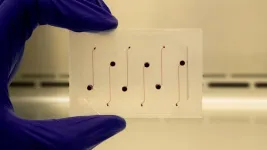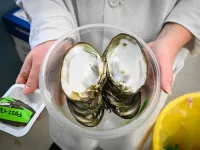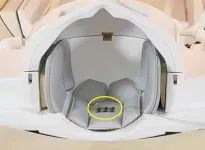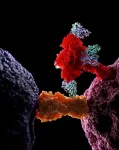(Press-News.org) Berlin, Germany: Cancer is the leading cause of disease-related death in children in most developed countries, and at least a quarter of these patients are diagnosed with aggressive high-risk or relapsed cancers, with an expected five-year survival rate of less than 30%. Accurate diagnosis can be difficult, and survivors often suffer life-long side effects because of the toxic treatments needed to cure them. Now, researchers from Australia have shown that, by using precision medicine*, it is possible not only to obtain more accurate diagnoses, but also that using precision-guided, targeted treatments earlier improves the two year progression-free survival in young cancer patients. Their results will be presented to the annual conference of the European Society of Human Genetics today (Saturday).
Associate Professor Vanessa Tyrrell, Director of the Zero Childhood Cancer National Precision Medicine Program (ZERO), a joint initiative of Children’s Cancer Institute, and Kids Cancer Centre, Children’s Hospital, Randwick, Australia, and colleagues at the nine child cancer centres around Australia, have enrolled over 1600 children into the program since 2017. Previously ZERO was limited to children with high-risk cancers, but recently expanded to be open to all children diagnosed with cancer in Australia, a trial the team are calling ZERO2. “Having found that over 70% of children with high-risk cancers were able to benefit from personalised medicine, we felt that we needed to see whether this benefit could be applied to other childhood cancers, too,” says Prof Tyrrell. “To date we have recruited over 700 children to this second trial, which we are aiming to continue for at least another four years.”
ZERO’s first national clinical trial, which ran from 2017 to 2022, has already produced results related to a child’s predisposition to cancer through gene variants in their germline (child genomic cancer risk). These variants were found in around 16% of children with high-risk cancer. Utilising whole genome sequencing (WGS) was more sensitive for the detection of germline cancer predisposition variants than standard clinical testing pathways; more than half had not been previously identified through standard clinical care, because the patients did not meet the testing criteria. Paired tumour-germline molecular profiling increased the germline cancer predisposition diagnosis rate and aided in genetic counselling for the families receiving these results. The findings of cancer risk led to high (nearly 67%) referral rates to cancer genetic services and, subsequently, the detection of relatives at risk of cancer. All first-degree relatives took up testing where it was recommended.
“This is not surprising to me, given that these children have developed cancer so young,” says Prof Tyrrell, “We also found that close to 70% of these germline variants were not previously known to be associated with the cancer type the patients presented with. This, together with the fact that over half the genetic cancer risk findings conferred a higher susceptibility to developing second cancers after chemotherapy, has significant implications for both treatment choices and ongoing surveillance.”
Of the newly identified variants, 80% had cancer surveillance/risk reduction implications for relatives, too. This is a much higher yield than is found in standard clinical practice and has significant implications for both patients and families, the researchers say. They now aim to continue to improve the application of precision medicine over time, focusing on the identification of new targets that drive an individual cancer; matching those targets to more effective, less toxic treatments and working out more effective, less invasive ways of monitoring how a child’s cancer is behaving; accelerating access to clinical trials as the ability to identify and match more targets to treatments is expanded; and transitioning precision medicine from research into standard health care systems.
“Only seven years ago, these aims seemed implausible to most people, and it was challenging in the beginning to encourage enrolment of children into ZERO. Today, clinicians and families are demanding this precision medicine model as standard of care for all their high-risk, relapsed, rare, and undiagnosable patients,” says Prof Tyrrell.
As well as identifying treatable cancers, ZERO aims to identify new genomic features, molecular targets and biomarkers that can lead to the development of more effective treatments. The researchers have already been able to characterise new cancer drivers and identify targeted drugs that may be effective in specific patients with specific alterations in their tumours. “Further, there have been cases where we have shown that novel alterations were also sensitive to another targeted drug that we did not expect, therefore potentially offering more therapeutic options to the patient.
“The tools needed to implement precision medicine more widely are not cheap, but its unquestionable promise in better stratifying the diagnosis and identifying the most likely effective targeted treatments for an individual’s cancer, together with the reduction in costs as technologies, computational capabilities, and automation improves leads me to believe that, in the future, multiomic profiling driving research-guided clinical care will be the gold standard, not just in cancer, but in many other diseases too,” Prof Tyrrell concludes.
Professor Alexandre Reymond, from the Center for Integrative Genomics, University of Lausanne, Lausanne, Switzerland, and chair of the conference, said: “Sequencing our genome in its entirety allows us to do much more than looking under the proverbial lamp post. As a human genetic society, ESHG should aim to make this standard clinical care."
(ends)
* Precision medicine optimises efficiency and therapeutic benefit for individual patients by using genetic and/or molecular profiling (“multiomics”) of their disease to enable the choice of the best treatment for them.
Abstract no. PL3.1 Zero Childhood Cancer National Precision Medicine Program: Improving outcomes for children with high risk cancer cancer utilising comprehensive, integrated multiomic profiling
END
Molecular profiling improves diagnosis and survival for children with high risk cancers
2024-06-01
ELSE PRESS RELEASES FROM THIS DATE:
New FRIB precision measurement program advances understanding of proton halos
2024-05-31
In May 2022, the Facility for Rare Isotope Beams (FRIB) at Michigan State University (MSU), launched its precision measurement program. Staff from FRIB’s Low Energy Beam and Ion Trap (LEBIT) facility take high-energy, rare-isotope beams generated at FRIB and cool them to a lower energy state. Afterward, the researchers measure specific particles’ masses at high precision.
The LEBIT team, led by Ryan Ringle, adjunct professor of physics at FRIB and in the MSU Department of Physics and Astronomy and senior ...
A greener, more effective way to kill termites
2024-05-31
UC Riverside scientists have discovered a highly effective, nontoxic, and less expensive way to lure hungry termites to their doom.
The method, detailed in the Journal of Economic Entomology, uses a pleasant-smelling chemical released by forest trees called pinene that reminds western drywood termites of their food. They follow the scent to a spot of insecticide injected into wood.
“We saw significant differences in the death rates using insecticide alone versus the insecticide plus pinene,” said UCR entomologist Dong-Hwan Choe, who led the discovery. “Without pinene, we got about 70% mortality. When we added it in, it was over 95%.
Native ...
Engineered circulatory systems may help fight disease
2024-05-31
The pharmaceutical drug development and approval process is a multi-step undertaking that requires a plethora of testing before reaching the market. Even then, humans respond differently to drugs depending on their individual bodies and medical needs.
Dr. Abhishek Jain, associate professor in the Department of Biomedical Engineering, and his lab received a grant from Texas A&M Innovation to continue developing an advanced vessel-chip deployment platform for large-scale pharmaceutical testing services that holds promise for ...
Moffitt Cancer Center and Virogen Biotechnology forge groundbreaking partnership to accelerate oncology and immunotherapy innovations
2024-05-31
TAMPA, Fla., and PLEASANTON, Calif. — Moffitt Cancer Center, a world-renowned cancer treatment and research center, and Virogen Biotechnology Inc., a clinical-stage biotechnology company, announced a groundbreaking strategic partnership today. This collaboration aims to propel the development of Virogen's cutting-edge fusion protein, VG712 (Resimmune), addressing significant unmet needs in oncology and immunotherapy.
Under this strategic alliance, Moffitt will offer Virogen priority access to ...
Ivonescimab plus chemotherapy in non–small cell lung cancer with EGFR variant
2024-05-31
About The Study: Ivonescimab plus chemotherapy significantly improved progression-free survival with tolerable safety profile in patients with non–small cell lung cancer who previously underwent EGFR tyrosine kinase inhibitor (EGFR-TKI) treatment and may offer a new treatment option for patients with TKI resistance.
Quote from corresponding author Li Zhang, M.D.:
“For patients with non-small cell lung cancer whose illness has progressed while receiving EGFR tyrosine kinase inhibitor (EGFR-TKI) therapy, especially the ...
Mussels downstream of wastewater treatment plant contain radium, study reports
2024-05-31
UNIVERSITY PARK, Pa. — Burrowed into streambeds and rarely moving for their decades-long lifespans, freshwater mussels are biomonitors, meaning they indicate how clean their environment is, according to Penn State researchers. As the bivalves feed on organic matter and filter the water around them, their inner tissues and hard shells begin to reflect whatever is in their environment — including radioactive particles.
A pair of researchers from Penn State’s Department of Civil and Environment ...
This self-powered sensor could make MRIs more efficient
2024-05-31
MRI scans are commonly used to diagnose a variety of conditions, anything from liver disease to brain tumors. But, as anyone who has been through one knows, patients must remain completely still to avoid blurring the images and requiring a new scan. A prototype device described in ACS Sensors could change that. The self-powered sensor detects movement and shuts down an MRI scan in real time, improving the process for patients and technicians.
During an MRI scan, a patient must stay entirely still for several minutes at a time, otherwise “motion artifacts” could appear and blur the final image. To ensure a clear picture, patient movement needs to be identified as ...
Cognitive declines preceding Alzheimer’s diagnosis lead to credit card, mortgage delinquency
2024-05-31
(May 31, 2024) — In the years prior to an Alzheimer’s disease or other memory disorder diagnosis, credit scores begin to weaken and payment delinquency begins to increase, concludes new research led by Georgetown University. The findings show consistent deterioration in these financial outcomes over the quarters leading up to diagnosis. The findings also show that credit card and mortgage delinquencies, specifically, both increase substantially prior to diagnosis.
The research was released today by the Federal Reserve Bank of New York (FRBNY). (“The Financial Consequences of Undiagnosed Memory Disorders”).
“Most memory disorders ...
Eye-tracking techniques could help primary care providers diagnose autism sooner, more accurately
2024-05-31
INDIANAPOLIS — Nearly 3% of all children in the United States are diagnosed with autism, according to the Centers for Disease Control and Prevention. But a collaborative team of researchers at Indiana University and Purdue University are finding ways to make the right diagnosis sooner.
“The number of children needing autism evaluations exceeds the capacity of specialists trained to provide this service,” said Rebecca McNally Keehn, PhD, assistant professor of pediatrics at the IU School of Medicine. “Children and their families are currently waiting a year or more to access evaluations. ...
Antibodies may aid effort to fight influenza B: Study
2024-05-31
Researchers at Vanderbilt University Medical Center have isolated human monoclonal antibodies against influenza B, a significant public health threat that disproportionately affects children, the elderly and other immunocompromised individuals.
Seasonal flu vaccines cover influenza B and the more common influenza A but do not stimulate the broadest possible range of immune responses against both viruses. In addition, people whose immune systems have been weakened by age or illness may not respond effectively to the flu shot.
Small-molecule drugs that block neuraminidase, a major surface glycoprotein of the ...





